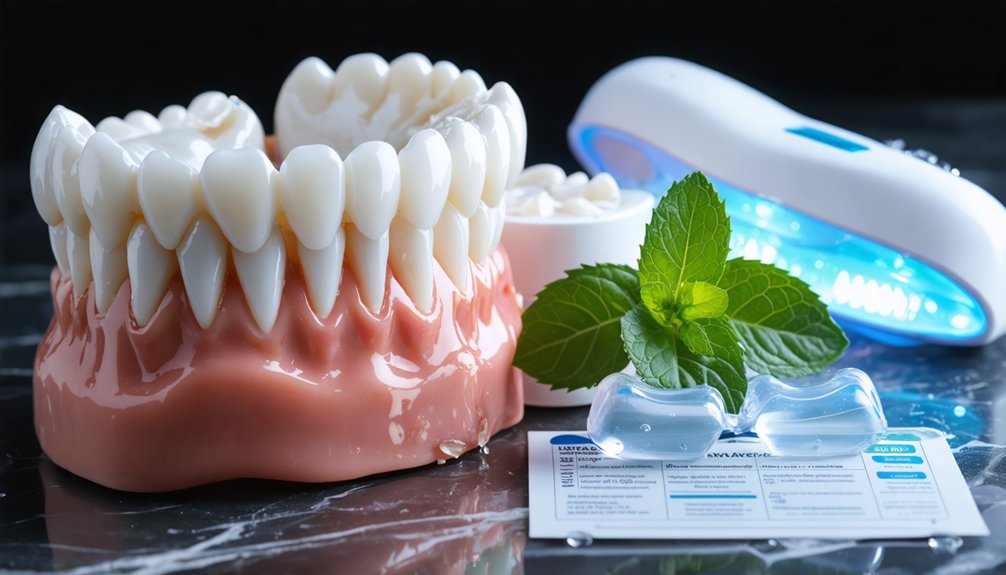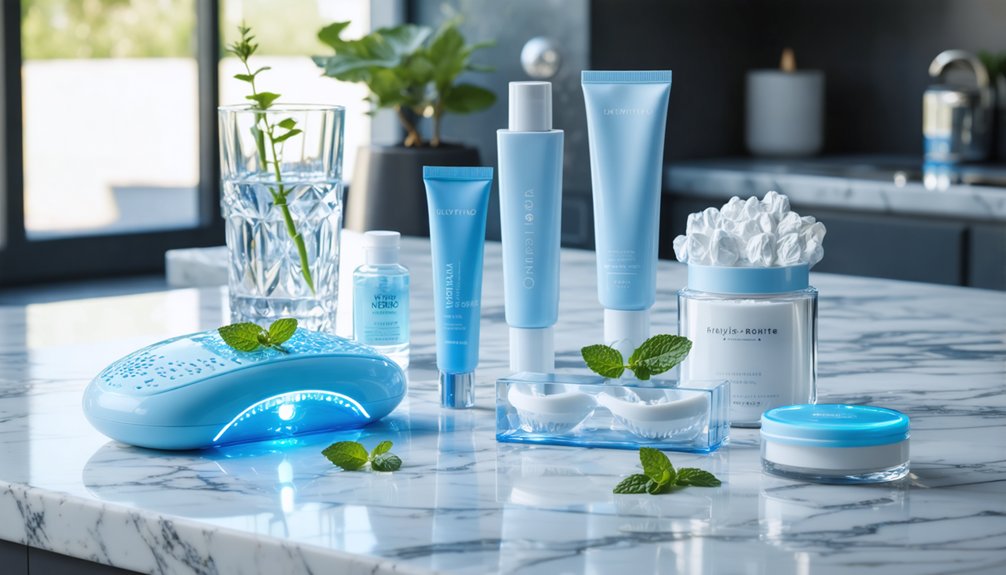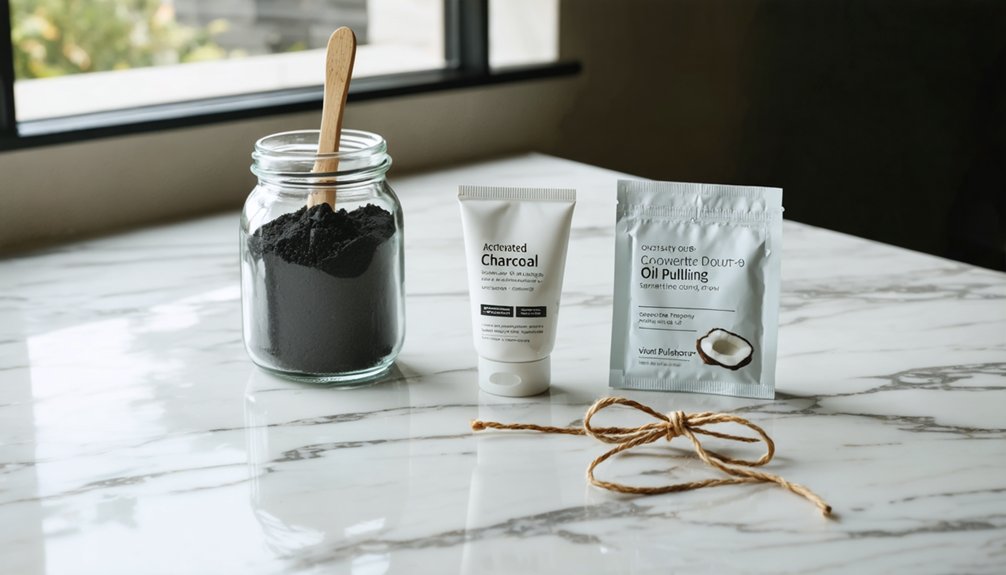For sensitive teeth, you’ll find gentle yet effective whitening options in Crest 3D White Whitestrips Gentle Routine Kit and Crest 3DWhitestrips Sensitive + LED Light, both featuring reduced peroxide levels. The Snow sensitive teeth kit combines low-intensity peroxide with LED technology, while Oral Essentials Lumineux Kit offers a peroxide-free alternative. Choose products containing potassium nitrate and fluoride as desensitizing agents. Understanding the right ingredients and application methods can help optimize your whitening results.
Key Takeaways
- Crest 3D White Whitestrips Gentle Routine Kit offers reduced peroxide levels specifically designed for sensitive teeth with gradual whitening effects.
- Snow’s sensitive teeth kit combines low-intensity peroxide with LED technology for effective yet gentle whitening treatment.
- Oral Essentials Lumineux Kit provides a peroxide-free alternative using natural ingredients for those with heightened sensitivity.
- Crest 3DWhitestrips Sensitive + LED Light features gentle formulation with light technology for quick 30-minute sessions.
- Professional-grade systems with low peroxide concentrations (3-6%) combined with desensitizing agents offer effective whitening with minimal discomfort.
Understanding Teeth Sensitivity and Whitening
While teeth whitening has become increasingly popular for achieving a brighter smile, it’s essential to understand how the process can trigger tooth sensitivity. The main sensitivity causes stem from whitening agents like hydrogen peroxide and carbamide peroxide, which temporarily increase tooth porosity through enamel demineralization.
Teeth whitening agents can cause temporary tooth sensitivity by increasing enamel porosity through chemicals like hydrogen peroxide and carbamide peroxide.
The whitening mechanisms involve these peroxides breaking down stain molecules through oxidation, but this process also exposes microscopic channels called dentinal tubules that connect to your tooth’s nerve. Modern professional whitening treatments often include anti-sensitivity medication to help minimize discomfort.
When these tubules are exposed, you’ll likely experience sharp, temporary pain – especially with hot, cold, or sweet stimuli. Most patients experience this sensitivity for days after treatment. If you have pre-existing conditions like thin enamel or exposed dentin, you’re at higher risk for sensitivity.
However, these effects typically resolve within two weeks as your teeth naturally remineralize.
Best At-Home Whitening Products for Sensitive Teeth
You’ll find several effective whitening options designed specifically for sensitive teeth, including Crest’s gentle strip formulations with natural oils and reduced peroxide levels.
For those seeking peroxide-free alternatives, products like Oral Essentials Lumineux Kit use natural ingredients such as sage oil and coconut oil to lift stains while minimizing discomfort. Daily brushing with desensitizing toothpaste can help maintain whiteness while building protective barriers on teeth. Starting with shorter application times of gentle whitening products can help minimize sensitivity while still achieving results.
Professional-grade systems like Snow’s sensitive teeth kit combine lower-intensity peroxide formulas with LED technology, allowing you to achieve whitening results while protecting your enamel.
Gentle Strip Options Available
Four leading whitening strip products stand out for those with sensitive teeth, offering gentler formulations without sacrificing effectiveness.
Strip efficacy studies and user experiences consistently validate these options for achieving noticeable results while minimizing discomfort. The strips are proven to remove 20 years of tough tooth stains with regular use. These products contain potassium nitrate to help minimize sensitivity during whitening treatment.
- Crest 3D White Whitestrips Gentle Routine Kit utilizes reduced peroxide concentrations specifically designed for sensitivity-prone teeth.
- Crest 3DWhitestrips Sensitive + LED Light combines gentle formulation with light technology, requiring 30-minute daily sessions.
- Crest 3D Whitestrips Sensitive White Kit delivers proven results across 14 treatments without triggering sensitivity.
- BURST Non-Slip Whitening Strips feature 6% hydrogen peroxide plus soothing ingredients like xylitol and aloe vera, showing results in just 15 minutes.
Each option incorporates advanced no-slip technology and enamel-safe formulas, allowing you to maintain your daily activities during treatment while protecting your teeth’s health.
Natural Whitening Alternatives
For those seeking gentler teeth whitening solutions, natural alternatives offer promising options that can minimize sensitivity while still producing noticeable results.
Using a soft-bristled toothbrush is essential when applying any natural whitening treatments to protect your enamel and prevent further sensitivity.
While some natural remedies like coconut oil pulling and baking soda mixtures have gained popularity, it’s important to separate whitening myths from proven methods.
Our customers report that Dead Sea Salt helps strengthen enamel while naturally whitening teeth over time.
You’ll find that sodium bicarbonate toothpaste and diluted hydrogen peroxide (1%) can effectively maintain whiteness without compromising enamel health. These alternatives are cost-effective and environmentally friendly, though results may take longer than commercial products.
When using natural methods, you’ll want to avoid overusing abrasive ingredients that could wear down enamel. Always consult your dentist before starting any whitening regimen, as certain dental conditions may require specialized approaches.
Remember to adjust ingredient concentrations based on your sensitivity levels.
Professional-Grade Take-Home Solutions
When seeking professional-grade whitening solutions for sensitive teeth, several trusted at-home options stand out in today’s market.
Professional-grade alternatives combine effectiveness with sensitivity management, offering you customized whitening experiences that protect your enamel while delivering results.
- Crest 3D White Whitestrips Gentle Routine Kit utilizes lower peroxide concentrations specifically designed for sensitive teeth.
- The Crest 3D White Whitestrips Sensitive + LED Light system delivers noticeable results with just 30-minute daily applications.
- TrueWhite Whitening Pen provides targeted application for precise, gentle whitening.
- Oral Essentials Lumineux Kit features peroxide-free formulation for reduced sensitivity.
These professional-grade solutions incorporate desensitizing agents like potassium nitrate and fluoride to strengthen enamel while whitening. Each product contains active whitening agents that penetrate the enamel to break down stubborn stains. Regular dental checkups help ensure safe whitening results while monitoring tooth sensitivity levels.
When used as directed, they offer a balanced approach between achieving brighter teeth and maintaining comfort.
Professional Whitening Options for Sensitive Smiles
Professional teeth whitening treatments offer sophisticated solutions for patients with sensitive teeth, combining advanced technology with carefully controlled application methods.
Your dentist will begin with a sensitive smile assessment to determine the most appropriate custom whitening techniques for your specific needs.
In-office options include laser treatments with hydrogen peroxide gel, which reduce exposure time while minimizing sensitivity.
Advanced systems like ZOOM! and Opalescence Boost can be tailored with lower-concentration gels and desensitizing agents.
LED-accelerated treatments provide faster results while maintaining gentleness through controlled light intensity and temperature monitoring.
Pre-treatment protocols may include desensitizing regimens and calcium phosphate treatments to strengthen enamel.
Following treatment, your dentist will apply protective coatings and provide specific maintenance instructions to guarantee lasting comfort and results.
Key Ingredients to Look for in Gentle Whitening Products
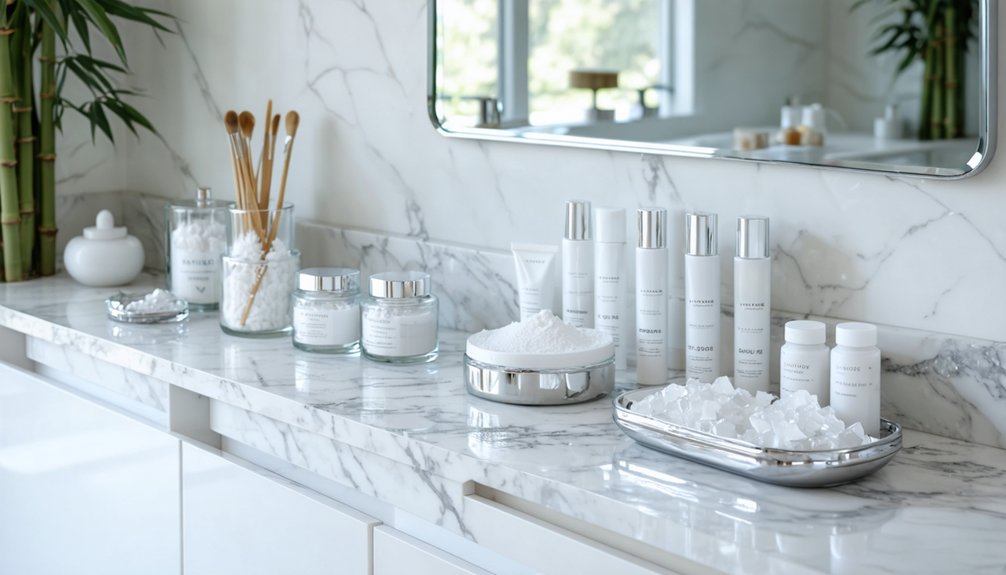
When selecting whitening products for sensitive teeth, you’ll want to focus on formulations containing proven desensitizing agents like potassium nitrate and fluoride.
Products with lower concentrations of peroxide (3-6% hydrogen peroxide or 10% carbamide peroxide) provide gentler whitening while minimizing discomfort and enamel damage.
You’ll achieve the best results with pH-balanced formulas that incorporate controlled-release peroxide technology, which allows for gradual whitening with reduced sensitivity risks.
Desensitizing Agents Matter Most
For individuals with sensitive teeth, desensitizing agents serve as essential components in whitening products, determining both comfort and treatment success.
Understanding the desensitizing mechanisms can help you choose the most effective solution for your patients’ needs.
When evaluating whitening products for sensitive teeth, look for these key desensitizing agents:
- Potassium nitrate at 5% concentration, which reduces sensitivity by calming nerve excitability in the dental pulp.
- Fluoride compounds that strengthen enamel and provide additional protection against sensitivity.
- Strontium-based ingredients that block exposed dentin tubules while simultaneously depolarizing dental nerves.
- Arginine and calcium additives that work together to seal dentin tubules and accelerate sensitivity relief.
These scientifically-proven ingredients guarantee your patients can complete their whitening treatments comfortably and effectively.
Low-Peroxide Formula Benefits
Low-peroxide formulas represent a significant advancement in teeth whitening technology, offering an ideal balance between effectiveness and safety for sensitive teeth.
These gentle whitening techniques utilize hydrogen peroxide concentrations below 10% or carbamide peroxide below 15%, which minimize enamel softening while still delivering noticeable results.
The low peroxide advantages extend beyond just reduced sensitivity.
You’ll find these formulas often combine peroxide with supportive ingredients like sodium bicarbonate and natural enzymes such as bromelain, enhancing stain removal without aggressive chemical action.
Through mild oxidation, these products break down stain molecules while preserving your enamel’s microstructure.
The slower-releasing nature of low-peroxide formulations, particularly those using carbamide peroxide, guarantees gradual whitening without the interprismatic enamel dissolution associated with higher-concentration treatments.
Safety Guidelines When Whitening Sensitive Teeth
The safety of teeth whitening procedures requires special consideration for those with sensitive teeth, as improper techniques can exacerbate discomfort and potentially damage dental health.
To dispel common whitening myths and avoid sensitivity triggers, you’ll need to follow specific precautions when pursuing teeth whitening treatments.
- Start using desensitizing toothpaste several weeks before beginning any whitening treatment to block dentin tubules and reduce sensitivity.
- Choose whitening products with lower peroxide concentrations specifically designed for sensitive teeth.
- Take over-the-counter pain medication before and after treatments to manage discomfort.
- Avoid acidic foods and extreme temperature beverages for at least 48 hours post-whitening to prevent additional sensitivity and enamel erosion.
Consult your dentist for customized treatment options that align with your sensitivity level.
Natural and Peroxide-Free Whitening Alternatives
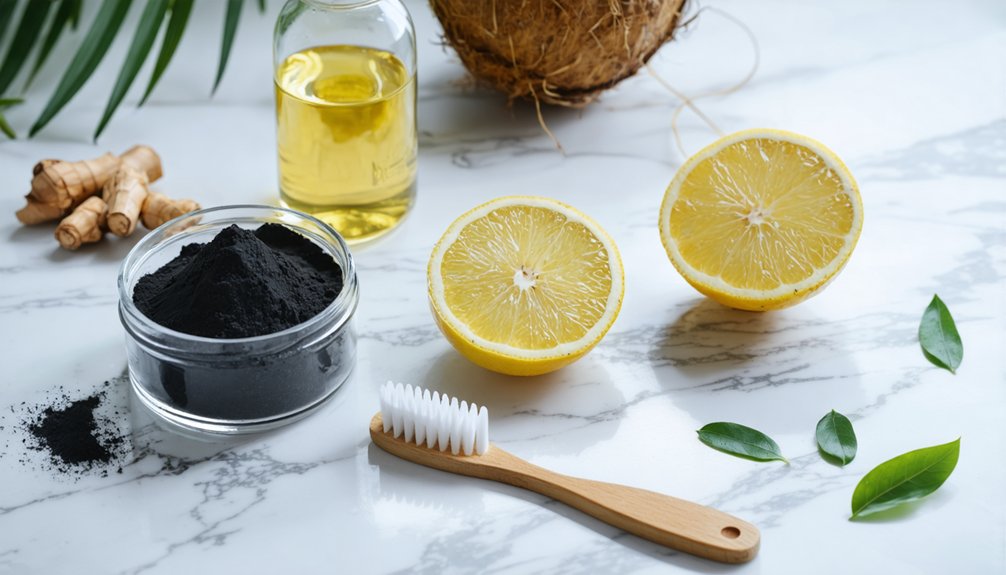
While traditional teeth whitening often relies on peroxide-based formulas, several natural alternatives can help brighten your smile without triggering sensitivity.
Baking soda mixed with water offers a gentle way to remove surface stains through mild abrasion, though it won’t affect deeper discoloration.
Oil pulling with coconut, sunflower, or sesame oil may help reduce bacteria and plaque, but scientific evidence for its whitening effects remains limited.
For natural whitening that prioritizes enamel preservation, focus on dietary changes by limiting stain-causing beverages like coffee and wine.
Incorporate crunchy, high-fiber foods such as apples and celery, which can help clean teeth surfaces mechanically.
Remember that while these methods are gentler than peroxide treatments, they’re most effective for maintenance and mild staining rather than dramatic whitening results.
How to Prepare Your Sensitive Teeth for Whitening
Preparing sensitive teeth for whitening begins with a thorough professional evaluation of your oral health. Your dentist will assess sensitivity triggers and dispel common whitening myths while creating a customized treatment plan that addresses your specific needs.
Before starting any whitening treatment, you’ll need to:
- Use a desensitizing toothpaste containing potassium nitrate or fluoride for 1-2 weeks to block nerve pathways.
- Receive professional fluoride treatments to strengthen your enamel and create a protective barrier.
- Eliminate acidic foods and beverages from your diet to minimize enamel vulnerability.
- Follow a strict oral hygiene routine with gentle brushing and daily flossing.
These preparatory steps help guarantee successful whitening outcomes while minimizing discomfort.
Your dentist will track your progress using baseline shade evaluations and adjust the treatment protocol as needed.
Maintaining Results While Managing Sensitivity
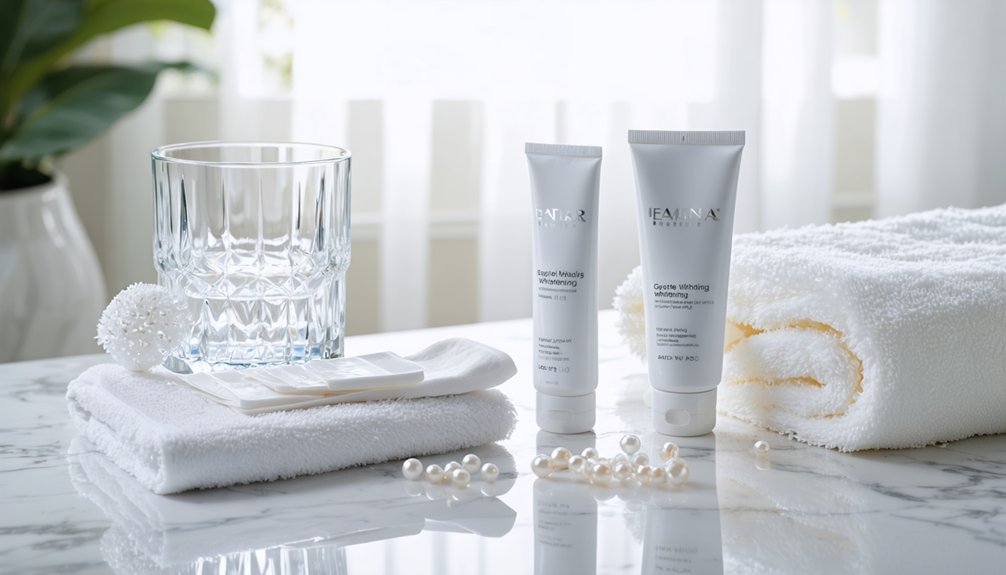
To maintain your whitening results while protecting sensitive teeth, you’ll need to establish consistent daily care routines that emphasize gentle techniques.
You can preserve your bright smile by using soft-bristled toothbrushes, sensitivity-formulated toothpaste, and avoiding extreme temperature variations that might trigger discomfort.
Following professional recommendations for periodic touch-ups, rather than frequent intensive treatments, will help you achieve lasting results without compromising your teeth’s comfort level.
Long-Term Whitening Care
Successfully maintaining teeth whitening results requires a careful balance between preserving brightness and managing sensitivity. For long-term effectiveness, you’ll need to establish a sustainable whitening frequency that doesn’t compromise your dental health.
Professional guidance is essential to develop a customized maintenance plan that addresses your unique sensitivity levels.
Consider these critical steps for lasting results:
- Space treatments appropriately, allowing 2-4 weeks between sessions
- Use desensitizing products consistently, especially potassium nitrate toothpaste
- Maintain professional oversight with regular dental evaluations
- Follow a sensitivity-conscious diet, avoiding extreme temperatures and acidic foods
Incorporate specialized maintenance products designed for sensitive teeth, and don’t hesitate to adjust your whitening schedule based on your comfort level.
Remember that sustainable results come from consistent, gentle care rather than aggressive treatments.
Gentle Daily Maintenance Routines
While maintaining whitening results requires ongoing attention, establishing a gentle daily maintenance routine is essential for those with sensitive teeth.
Use a soft-bristled toothbrush and apply minimal pressure during gentle brushing to protect your enamel from abrasion. Replace your toothbrush every three months to guarantee effective yet gentle cleaning.
For enhanced enamel protection, choose desensitizing toothpaste containing potassium nitrate and fluoride.
Consider using an electric toothbrush with pressure sensors to prevent aggressive brushing. After consuming staining beverages, rinse with water immediately and use a straw when possible.
Strengthen your enamel by incorporating calcium-rich foods into your diet, and limit acidic and sugary items that can increase sensitivity.
Regular use of fluoride-based products will help remineralize your enamel while maintaining your whitening results.
Professional vs. Over-the-Counter Solutions
When choosing between professional and over-the-counter teeth whitening solutions, the concentration of active ingredients plays a crucial role in both effectiveness and sensitivity.
While professional treatments offer stronger formulations with up to 35% hydrogen peroxide, OTC products typically contain gentler concentrations between 3-10%, making them more suitable for sensitive teeth.
- Professional in-office treatments deliver dramatic results quickly but cause universal tooth sensitivity.
- OTC whitening strips and trays provide gradual improvement with minimal discomfort.
- Professional take-home kits with custom trays offer a middle ground, combining effectiveness with controlled application.
- Dentist-supervised treatments can be adjusted based on your sensitivity levels.
For moderate to severe staining, you’ll achieve better results with professional treatment, while mild discoloration often responds well to OTC products designed specifically for sensitive teeth.
Essential Care Tips During the Whitening Process
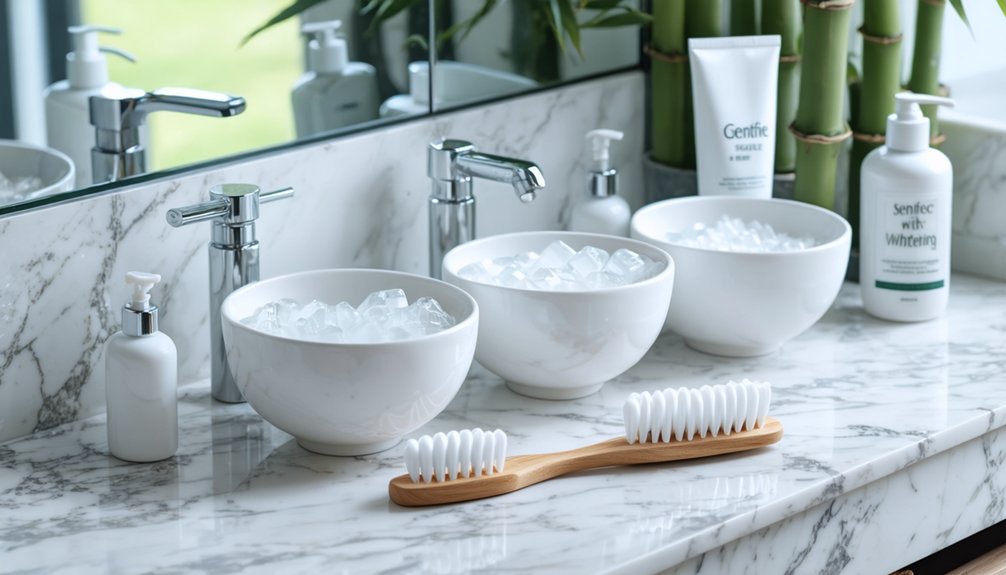
The proper care and maintenance during teeth whitening can make the difference between a comfortable experience and one marked by sensitivity. Start by using desensitizing agents containing potassium nitrate or fluoride at least two weeks before treatment.
Take control of your whitening experience by preparing your teeth with desensitizing products before treatment begins.
During the process, protect your enamel health by using lower peroxide concentrations and reducing whitening frequency if you experience discomfort. Line your custom trays with sensitivity toothpaste after each session and wear them for 10 minutes.
Post-treatment, avoid hot, cold, or acidic foods for 48 hours while your teeth recover. Use a soft-bristled brush and gentle technique to prevent enamel damage.
If you notice persistent sensitivity or gum irritation, contact your dentist immediately. Regular salt water rinses can help soothe minor soft tissue irritation.
Frequently Asked Questions
How Long Should I Wait Between Whitening Treatments if I Have Sensitive Teeth?
Like a gentle tide’s rhythm, you’ll want to space your treatments 2-3 weeks apart to protect against teeth sensitivity. For at-home whitening frequency, wait at least 14 days between sessions.
Can Certain Medications Affect Tooth Sensitivity During Whitening Treatments?
Yes, many medications like antidepressants and antihistamines can increase your tooth sensitivity during whitening. You’ll need proper sensitivity management and should consult your dentist about medication interactions before treatment.
Are Whitening Products Safe to Use With Dental Crowns or Veneers?
You’ll need to be cautious with whitening techniques since crown materials won’t whiten like natural teeth. Consult your dentist first, as whitening products can affect restoration bonds and create color mismatches.
Does Drinking Through a Straw Help Prevent Sensitivity During Whitening Treatment?
You’re barking up the wrong tree with straw usage. While straws can prevent staining, they won’t reduce sensitivity during whitening treatments since peroxide penetration through enamel causes the discomfort.
Can Pregnancy Affect Tooth Sensitivity When Using Whitening Products?
Yes, pregnancy hormones greatly increase tooth and gum sensitivity, making whitening treatments more uncomfortable. You’ll want to postpone whitening until after pregnancy to protect your dental health and avoid discomfort.
References
- http://www.goochlanddentistry.com/whats-the-best-teeth-whitener-for-sensitive-teeth/
- https://smiledailey.com/teeth-whitening-for-sensitive-teeth-is-it-safe/
- https://www.westriverdentalcare.com/best-teeth-whitener-for-sensitive-teeth/
- https://www.gentledental.com/resources/articles/teeth-whitening-products
- https://www.trysnow.com/blogs/news/teeth-whitening-for-sensitive-teeth-solutions-and-treatments
- https://crest.com/en-us/oral-care-products/3d-whitestrips/crest-3dwhitestrips-sensitive-led-light-at-home-teeth-whitening-kit
- https://harrisburgsmilesdental.com/why-does-teeth-whitening-cause-sensitivity-understanding-the-basics/
- https://www.wauwatosadentists.com/does-teeth-whitening-cause-tooth-sensitivity/
- https://www.colgate.com/en-us/oral-health/tooth-sensitivity/managing-sensitive-teeth-after-whitening
- https://pmc.ncbi.nlm.nih.gov/articles/PMC4058574/
